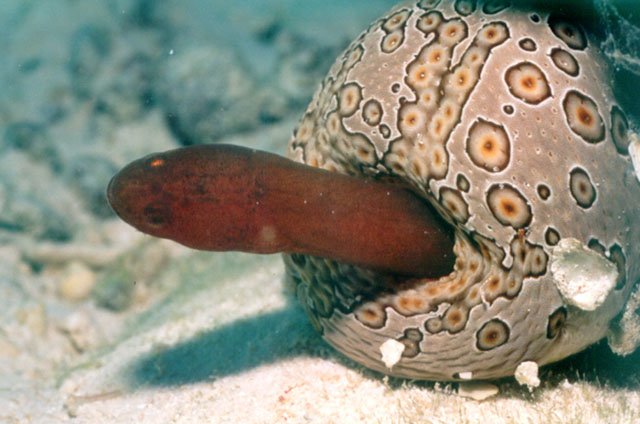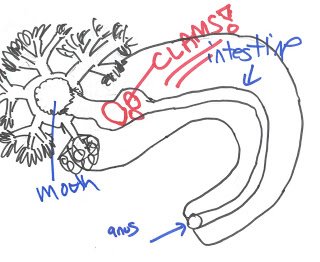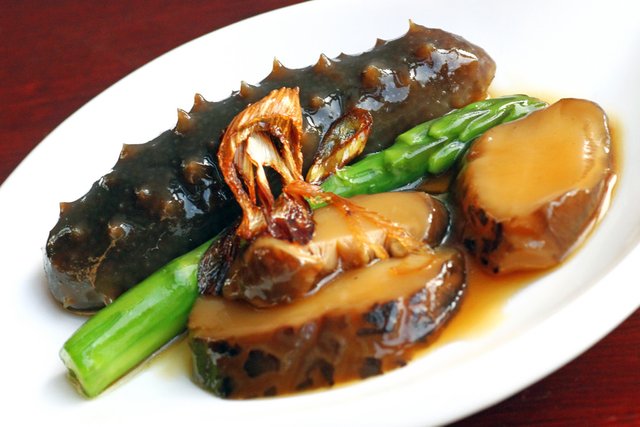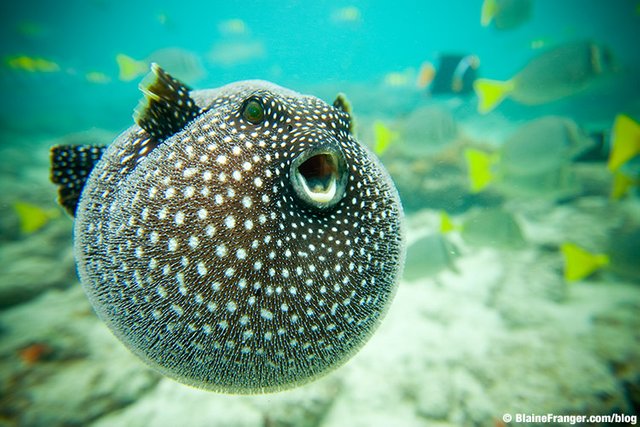A multi-billion dollar sea food and a promising candidate for the cancer treatment
Hey Steemians,
Today, In the series of "Amazing Creatures" I have a sea creature which is highly prized, produced and harvested in tonnes as a popular dish and also used as Chinese and other Asian country folk medicine (1).
Sea cucumbers are marine animals belongs to phylum Echinodermata, they have leathery skin and an elongated body containing a single, branched gonad. The sea cucumbers are named so because of their resemblance to cucumber. They have an endoskeleton just below the skin, calcified structures that are usually reduced to isolated microscopic ossicles joined by connective tissue (Wikipedia).

Firstly let me give some introduction about sea cucumber about their body, behavior and defense mechanism after that we will move for therapeutic uses. Sea cucumbers belong to the class of holothurian. They have radial symmetry and have weak bilateral symmetry transversely with a dorsal and a vertical surface. The mouth is surrounded by a ring of tentacles which are retractable into the mouth. Around the tentacles they have circular muscles contraction of which helps the tentacles to elongate and introvert to extend. The body is covered with smaller calcareous ossicles. They can be differentiated on the basis of ossicles into different species.

The digestive system begins from their mouth, pharynx lies just behind the mouth and is surrounded by a ring of ten calcareous plates. Many species also possess an oesophagus and stomach, but in some species pharynx opens directly into the intestine. They are found in sea substratum so they are mainly scavengers, alongwith this some of the species shows commensal relationship with deep sea anglerfish (Brusca, R.C.; Brusca, G.J. (1990). Invertebrates. Massachusetts: Sinauer Associates). For capturing food sea cucumbers face in the direction of currents and catches food with tentacles.
The locomotive organ of sea urchins is made up of five strip-like ambulacral running along the length of their body straight from mouth to anus, that allow them to crawl along the sea substratum. They do not possess any sensory organs but some species have statocysts or small eye-spots near bases of their tentacles. Sea cucumbers mainly communicate by sending signals (hormones) through the water, they mainly communicate for reproduction.
They show commensal or symbiotic relation with many sea animals, as well as with parasites. Species like pearl fish shows a commensal behavior with sea cucumber, pearl fish lives in the cloaca of sea cucumber seeking protection from predation, gets nutrition from the passing food with water and sometimes they stay till their growth to adult stage.

Some bivalve’s clams found shelter in the oesophagus of sea cucumber. But the question is how?? In case of mussles uses byssal threads to attach to rocks or sea hulls, so the same mechanism they use to attach the oesophagus of the sea cucumber.


Lissocarcinus orbicularis, a symbiotic crab
To survive in the competitive world everyone need to have defensive mechanisms to win, so sea cucumbers also possess defensive mechanisms to combat the their predators. For defence sometimes they produce toxin specifically holothurin. Although on more powerful predators like Tonna galea, this toxin is not effective as they produce stronger toxin which paralyzes them before swallowing ("Predation by the gastropodTonna perdix (Gastropoda: Tonnoidea) on the holothurian Actinopyga echinites(Echinodermata: Holothuroidea) on a reef of Réunion"). Another defensive mechanism is that they expel their sticky tubules to entangle predators.
Sea cucumber found a very big commercial market in food industry. It is harvested and used in various foods and also dried and transported.


THERAPEUTIC USE OF SEA CUCUMBERS
Sea cucumbers show very good profile of high protein, low sugar and fat content, and no cholesterol. Along with they are also full of many valuable vitamins and minerals like vitamin A, B1 (thiamine), B2 (riboflavin), B3 (niacin) and minerals like calcium, magnesium, iron, copper, manganese and micronutrients (2). Sea cucumbers are also rich source of essential amino acids; most abundant are glycine, glutamic acid, aspartic acid, alanine and arginine (3). It is believed that sea cucumbers contain several compounds which have anticancer properties. Frondoside A, a glycoside derived from the orange-footed sea cucumber, Cucumaria frondosa, is found to be potential candidate to inhibit pancreatic cancer cell growth and induce apoptosis and they also have antimetastatic activity (4). Along with Frondoside A others extracts have also shown anticancer activity. Like mucopolysaccharide found in the body wall of sea cucumber isolated from Stichopus japonicus as potential candidate for treatment of hepatocellular carcinoma (5).
Many scientists have shown that the extracts from sea cucumbers have antibacterial activities and they are source of many bioactive compounds which are antibacterial and antifungal in nature. The extracts also have antiviral and antiparasitic properties. A crude extract from Holothuria sp. have shown antiviral activity against herpes simplex virus (6). Sea cucumbers extracts have also reported to be anti-oxidant in nature. It has been shown that crude extracts of various species sea cucumber has capacity of scavenging free radicals (7). Alzheimer’s is a very common neurodegenerative disease and many scientists have shown that bioactive compounds from Sea cucumber have been identified as potential therapeutic agent against oxidative damage of nervous system. Wu group in 2014 has shown that eicosapentaenoic acid-enriched phospholipids extracted from Cucumaria frondosa prevent oxidative damage by inhibiting mitochondria mediated apoptosis pathway (8). Along with these properties they are also antihyperglycemic (potential therapy for diabetes mellitus), antihypersensitive, anti-inflammatory and antihyperlipidemic activity (beneficial effect on lipid merabolism) (9).
An extensive list of their properties has made them a subject of intense research and source of many therapeutic agents.
References
https://en.wikipedia.org/wiki/Sea_cucumber
Wen et. al., 2010 Chemical composition and nutritional quality of sea cucumbers. 90(14): 2469-2474

You may like to see my other posts on Amazing Creatures:
Amazing Creatures #1 Poisoned Dart frogs are getting more than just food from Ants
Amazing Creatures #2 Painkilling Pufferfish
Hope you have found this article interesting. If you do, please upvote and resteem.
Happy Reading :)
Vinamra
Being A SteemStem Member
Downvoting a post can decrease pending rewards and make it less visible. Common reasons:
Submit
did you know it? sea cucumbers are never dead
Downvoting a post can decrease pending rewards and make it less visible. Common reasons:
Submit
Thanks for reading the post
You can share the truth thenThey are scavengers.....they eat dead and the discarded matter
and they can also die because we eat only the dead.... :)
Downvoting a post can decrease pending rewards and make it less visible. Common reasons:
Submit
Excellent ...! no.. comments .. u r exported
Downvoting a post can decrease pending rewards and make it less visible. Common reasons:
Submit
Thanks you, I'm glad you like it.😃
Downvoting a post can decrease pending rewards and make it less visible. Common reasons:
Submit
Being A SteemStem Member
Downvoting a post can decrease pending rewards and make it less visible. Common reasons:
Submit